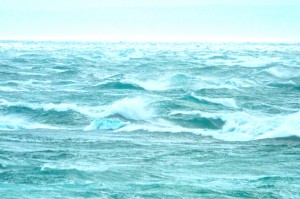Update at 17:40
Since writing the log the wind turned to west, southwest and came up even stronger. We have sustained gusts up to 62.7 knots. Seas are coming over the helipad and the tank-shed and boat shed roofs are being stripped off and are flying past the house. Yikes.
Sustained east, southeast winds of 30 to 40 knots, gusting to over 50, pushed seas up into breaking whitecaps this morning. Large breakers rolled down the jetty and rose up around the derrick base making seawater sampling impossible. Under heavy skies, waves crashed against the eastern face of Great Race and flying sheets of salt spray dominated the small landscape here. There was even a pocket of sea foam building up on the boulder beach and foam was flying right across the island.
Barometric pressure dropped overnight and kept going down in the morning, reaching 982 HPa by early afternoon. The highest gusts were observed late morning 53.4 knots on the Lighthouse system which we can monitor in the kitchen. Gale warnings continue and the forecast is calling for a turn to strong westerlies in the afternoon, diminishing to southwest 15 to 20 overnight. As this log is posted at ~15:00, there is no sign of it letting up and the rain has started.
It was not a day for small vessels to be out and none were seen. Pan pans on the VHF radio included an overturned Junior Flyer with a father and son (a child), clinging to the hull of the overturned vessel. Their call originated in Puget Sound and the US Coast Guard rescued them. What was that man thinking?
There is obviously a great deal of mixing going on in the sea, with all the wind and wave energy churning things. That means spring phytoplankton blooms are still some time away and early herring spawns may produce larvae that go hungry. Stratification (stable layering of the water) becomes possible when less dense surface waters (warmer, less salty, or both), float on top of denser seawater (saltier, colder or both). That layering in surface waters gives some stability for growth of photosynthetic plankton that drive the food chain and rely on light. Light levels are returning, there are lots of nutrients, so as soon as it calms down for a while there should be a plankton ‘bloom’.
On the bottom, microscopic Bull Kelp ‘plants’ are starting to grow now. They will be full size by July after phenomenal growth fuelled by sunlight and nutrients. A few ‘old growth’ Bull Kelp were visible today, silhouetted through the waves on breaking reefs; for brief seconds as the waves crested, they stretched out fully vertical. Bull Kelp clings with tenuous holdfasts anchored through storms and calm. They are considered to be an annual species and don’t generally last much more than a year so the ones still here are very hardy.
The wild goose chase continued today as if the weather wasn’t enough to ward them off. It was too windy for the eagles and the gulls were hunkered down in nooks and hollows head into the wind in order to stand their ground against the wind. A few of the larger sea lions managed to haul out mid day. It looked too difficult (and dangerous) for the smaller animals that were seen cavorting in the waves. Again there was no sign of seals or guillemots.
Landing would have been impossible today. Even at low tide, big breakers were sweeping the jetty. Chores were routine as wind and spray permitted.

